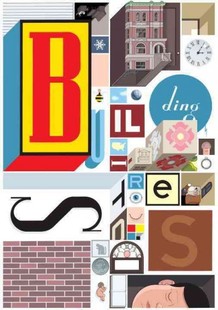Building Stories
| Building Stories | |
|---|---|
 |
|
| Date | 2012 |
| Page count | 200 pages |
| Publisher | Pantheon Books |
| Creative team | |
| Creator | Chris Ware |
| ISBN | |
Building Stories is a 2012 graphic novel by American cartoonist Chris Ware. The unconventional work is made up of fourteen printed works—cloth-bound books, newspapers, broadsheets and flip books—packaged in a boxed set. The work took a decade to complete, and was published by Pantheon Books. The intricate, multilayered stories pivot around an unnamed female protagonist with a missing lower leg. It mainly focuses on her time in a three-story brownstone apartment building in Chicago, but follows her later in her life as a mother. The parts of the work can be read in any order.
The protagonist of Building Stories is an unnamed woman with brown hair who suffered the loss of the lower half of her left leg in a childhood boating accident. She comes to inhabit the third floor of a three-story apartment building, with a couple who constantly argue on the second floor and the elderly landlady on the first. The woman sees herself as a failed artist, and the work follows her in the Chicago brownstone apartment building in her twenties. Later in life as a mother, she puts on weight and feels her creativity stifled by domesticity. She still thinks of her first boyfriend, who left her after an abortion, and feels frustrated with her husband.
In the story "Touch Sensitive", people from the future wearing glass helmets peer down on a couple who reside on the building's second floor. They use a technology that can read fragments of memories from an "area's consciousness cloud" and witness the potential breakup of the couple. In the future, the female protagonist, now a mother, tells her child the story of Branford the Best Bee in the World. Branford appears in a stapled pamphlet and a newspaper in the set. After being squashed, he becomes Branford the Benevolent Bacterium. One of the books, resembling a Little Golden Book, charts the happenings in the three-story building on 23 September 2000. There is a large foldout resembling a game board, a Sunday comics-like section, a long, accordion-like foldout section, and other segments difficult to categorize. Some of the stories focus on a single character, such as the thoughts of the landlady, or the story of how the arguing couple met.
The buildings figure prominently in the story. The thoughts of the apartment building in which most of the story takes place are displayed in cursive lettering. The female protagonist is unable to escape the omnipresence of death in the suburban home in Oak Park, Illinois, where had previously lived—her closest college friend commits suicide, her cat dies, she flushes a baby mouse down the toilet, and she is tormented about what to believe about abortion.
...
Wikipedia
